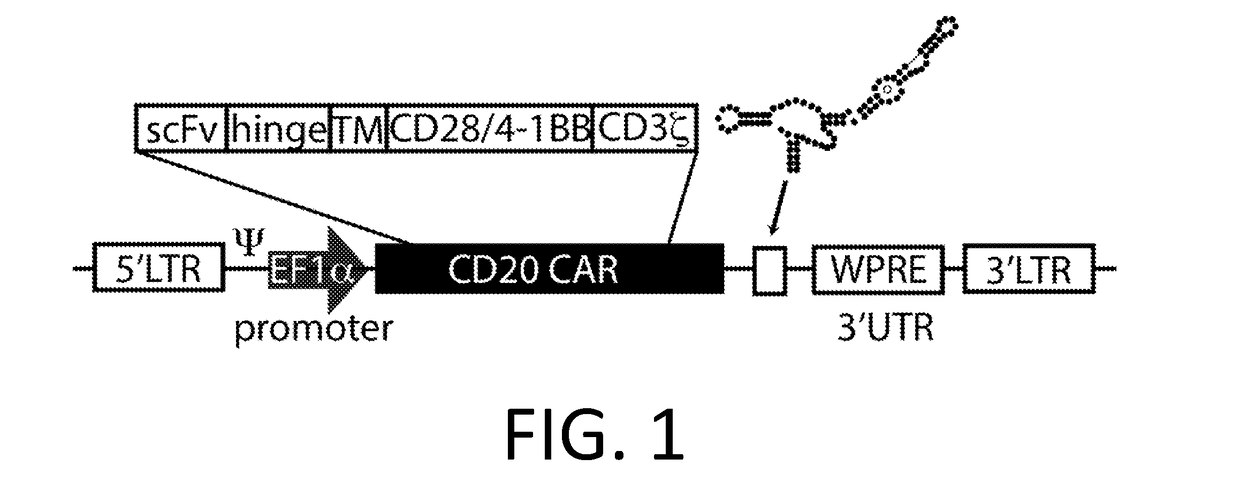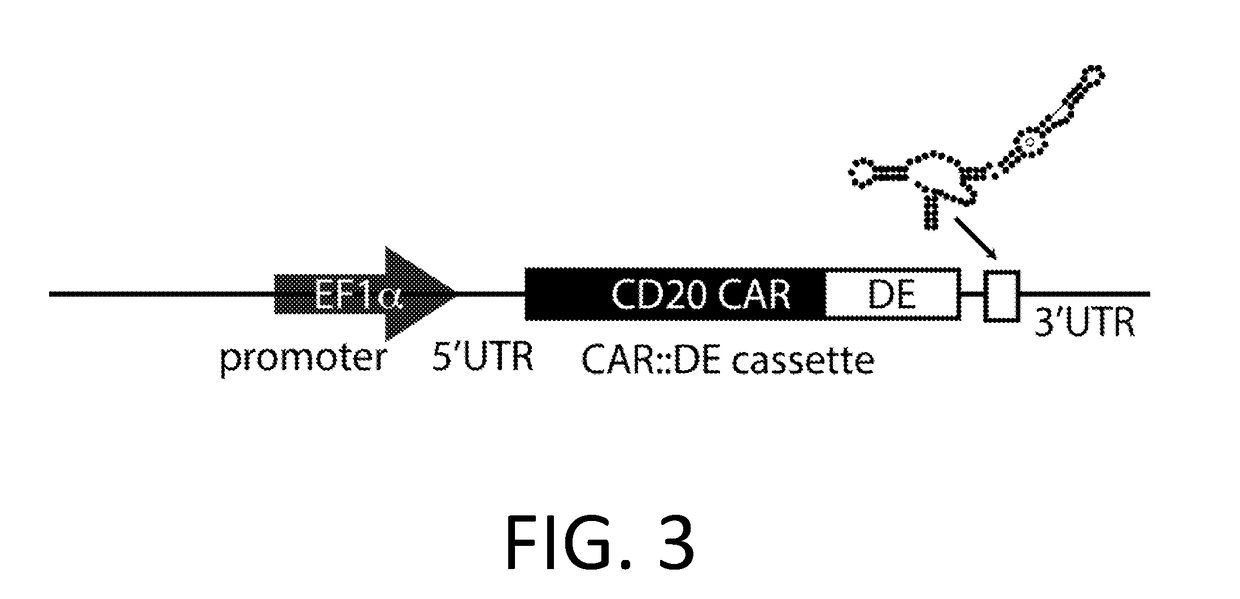Smart CAR Devices and DE CAR Polypeptides for Treating Disease and Methods for Enhancing Immune Responses
a technology for enhancing immune responses and smart cars, applied in the direction of immunoglobulins, peptides, antibody medical ingredients, etc., can solve the problems of sacrificing the surveillance benefit of transient car exposure approaches, unable to provide an adequate safeguard against toxicity, and unable to detect toxicities in patients, so as to increase the number of granules, increase the killing effect of target cells and increase the number of lytic proteins
- Summary
- Abstract
- Description
- Claims
- Application Information
AI Technical Summary
Benefits of technology
Problems solved by technology
Method used
Image
Examples
example 1
c Antigen Receptor Targeted to CD123
[0224]A CAR is made using the anti-CD20 CAR cassette described in Budde 2013 (Budde et al. PLoS1, 2013 doi:10.1371 / journal.pone.0082742, which is hereby incorporated-by-reference in its entirety for all purposes), with an anti-CD123 mAb scFv (WO 2014 / 144622 and US20140271582, which are incorporated by reference in their entirety for all purposes) replacing the anti-CD20 extracellular domain. In an embodiment, the anti-CD 123 CAR also encodes the RNA control device, 3XL2bulge9 (Win and Smolke 2007 Proc. Natl Acad. Sci. 104 (36): 14283-88, which is hereby incorporated by reference in its entirety for all purposes), and / or the destabilizing element (DE) ecDHFR described in Iwamoto 2010 (Iwamoto et al. Chemistry and Biology, 2010 doi:10.1016 / j.chembiol.2010.07.009, which is hereby incorporated by reference in its entirety for all purposes). A nucleic acid encoding the anti-CD20 CAR cassette is engineered to replace the anti-CD20 extracellular domain w...
example 2
c Antigen Receptor Targeted to CD133 (AML)
[0227]A CAR is made using the anti-CD20 CAR cassette described in Budde 2013 (Budde et al. PLoS1, 2013 doi:10.1371 / journal.pone.0082742, which is hereby incorporated-by-reference in its entirety for all purposes), with the anti-CD133 mAb 293C3-SDIE is used for the extracellular element (Rothfelder et al., 2015, ash.confex.com / ash / 2015 / webprogram / Paper81121.html, which is incorporated by reference in its entirety for all purposes) replacing the anti-CD20 extracellular domain. In an embodiment, the anti-CD133 CAR also encodes the RNA control device, 3XL2bulge9 (Win and Smolke 2007 Proc. Natl Acad. Sci. 104 (36): 14283-88, which is hereby incorporated by reference in its entirety for all purposes), and / or the destabilizing element (DE) ecDHFR described in Iwamoto 2010 (Iwamoto et al. Chemistry and Biology, 2010 doi: 10.1016 / j.chembiol.2010.07.009, which is hereby incorporated by reference in its entirety for all purposes). A nucleic acid encodi...
example 3
c Antigen Receptor Targeted to CD133 (AML) in a FasL Knock Out T-Lymphocyte
[0230]A CAR is made using the anti-CD20 CAR cassette described in Budde 2013 (Budde et al. PLoS1, 2013 doi:10.1371 / journal.pone.0082742, which is hereby incorporated-by-reference in its entirety for all purposes), with the anti-CD133 mAb 293C3-SDIE is used for the extracellular element (Rothfelder et al., 2015, ash.confex.com / ash / 2015 / webprogram / Paper81121.html, which is incorporated by reference in its entirety for all purposes) replacing the anti-CD20 extracellular domain. In an embodiment, the anti-CD133 CAR also encodes the RNA control device, 3XL2bulge9 (Win and Smolke 2007 Proc. Natl Acad. Sci. 104 (36): 14283-88, which is hereby incorporated by reference in its entirety for all purposes), and / or the destabilizing element (DE) ecDHFR described in Iwamoto 2010 (Iwamoto et al. Chemistry and Biology, 2010 doi: 10.1016 / j.chembiol.2010.07.009, which is hereby incorporated by reference in its entirety for all...
PUM
| Property | Measurement | Unit |
|---|---|---|
| Cytotoxicity | aaaaa | aaaaa |
Abstract
Description
Claims
Application Information
 Login to View More
Login to View More - R&D
- Intellectual Property
- Life Sciences
- Materials
- Tech Scout
- Unparalleled Data Quality
- Higher Quality Content
- 60% Fewer Hallucinations
Browse by: Latest US Patents, China's latest patents, Technical Efficacy Thesaurus, Application Domain, Technology Topic, Popular Technical Reports.
© 2025 PatSnap. All rights reserved.Legal|Privacy policy|Modern Slavery Act Transparency Statement|Sitemap|About US| Contact US: help@patsnap.com



